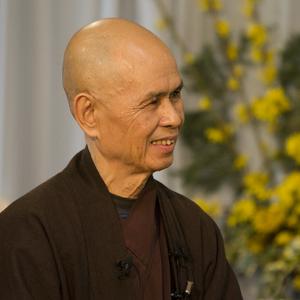Making Peace with Ourselves
The date is November 25, 2001 at Plum Village, Upper Hamlet. This is the first talk of the 3-month winter retreat. The talk is offered in English.
00:00 Connecting with Green Mountain Dharma Center and Deer Park Monastery09:10 Chanting34:12 Going Home to Ourselves41:08 Drinking our Tea43:22 Mindfulness of our Body46:04 Body52:50 Feelings56:26 Perceptions1:01:38 Mental Formations1:05:14 Consciousness1:06:01 Reclaiming Our Sovereignty1:14:01 The Sangha1:17:58 The Energy of Mindfulness1:24:55 Healing from Within1:29:04 Looking Deeply1:37:53 Building a Sangha
What is the 3-month retreat? How do we practice together? Our practice is to build brotherhood. How do we know if we are succeeding in our practice? To practice to be happy together. It is a kind of daily food. Through our sitting mediation, walking meditation, eating in mindfulness. These help build our sisterhood and brotherhood. This is done by building peace within ourselves so it can manifest around us.
The Energy of Mindfulness
Buddhist meditation has a universal value. The energy of mindfulness help us to there, to be fully present in every moment of our daily life. To be there for us. Our body, our feelings, our perceptions - they are all there, but are we taking care of them? Our practice is to go home to ourselves and tend to our feelings, perceptions, and our body. Our tendency is to run away from ourselves.
Drinking our tea. Are we fully present to drink our tea? Or are you drinking like a machine? Mindfulness of drinking. Everyone can do that. If we are not careful, we may follow our habit. Mindfulness is the energy to be there for what is going on. Through breathing, walking, eating, etc.
Mindfulness is the kind of energy that helps you to be fully there. This is the first action for peace. Have you abandoned yourself? Mindfulness can help you come back to yourself. We start with our body. Your breath is part of your body. When you breathe in, bring your mind back. Mindful breathing. This is the best way to begin making peace. It is the door in which you can come back to yourself. We can restore ours sovereignty in the territory of ourselves.
The Five elements (Skandhas)
The first element is form - your physical body. Our physical body is like a river; it is always flowing. The first thing a practitioner should do is make peace with our body. Learn how to calm and renew your body. Learn the art of deep and total relaxation. Give our body a chance to rest and restore itself. It is an action of peace. In the Harvard medical school, they have studied the role of meditation in healing the body. Breathing in, I calm my body. Breathing out, I smile to my body.
The second element of your person is feeling. The painful feelings, pleasant feelings, neutral feelings. All kinds of feelings. Like the body, there is a river of feelings. They are born, remain, and affect other aspects of our person. Are you taking care of your feelings? Your emotions? Our tendency is to run away. Breathing in, I am aware of my feeling. Breathing out, I calm my feeling. They are like a suffering baby and they have been left alone. We need to take care of this territory of feelings.
The third portion of our territory is perception. We perceive realities, we have an image of ourselves. That is a perception. We have an image of the other person, or other group of people. This is a perception. And very often they are wrong. And because of our wrong perceptions, we suffer very deeply. There are a lot of contradictions.
In the Buddhist tradition, the physical body is called a formation. Formation is a technical term that means anything that manifests based on conditions. For example, a flower. Our body is formation. Our feelings are also a kind of formation, but we call it a mental formation. The fourth element is mental formations. According to Buddhist psychology, we have defined 51 mental formations. And mindfulness is one of the mental formations; we s...

